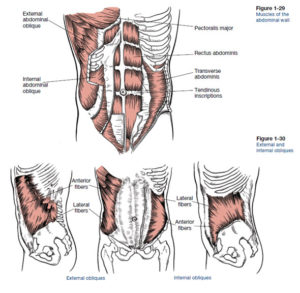Sure, we all want abs, but what lies beneath is perhaps one of the most important structures in the human body: the core. Keeping core muscles strong and stable ensures good posture, functional movement and structural alignment. But strengthening this dynamic set of muscles takes more than a few crunches. Read on to learn about the importance of core stability and the most effective ways to strengthen the entire core.
What is the Core?
It’s important to define what the “core” means, as some may assume it looks like a well-defined six-pack (which is actually just one group of muscles that happen to be positioned in the most visible part of the abdomen). There are around 35 muscles that are considered a part of the core, wrapping the area around stomach, back, hips and pelvis. This group of superficial and deep muscles work together to create a stable structure for the spine and pelvis. Most notably, the core muscles consist of pelvic floor muscles, internal and external obliques, rectus abdominus, erector spinae, transverse abdominus, longissimus thoracis and the diaphragm. These muscles are responsible for trunk flexion, extension, and rotation, as well as lateral movements, compression of the abdomen and spinal stability.

Source: ACE Fitness
Why Core Strength is Important
Ask any physical trainer or exercise physiologist and they will agree: core strength is crucial for safe movement in physical activity, as well as posture, balance, and alignment throughout life. When core muscles are strong and stable, movement and posture are optimized. Core muscles serve as the source of movement and center of gravity for the body, allowing downstream structures like the foot and knee to move with stability – almost like an anchor to the muscles and bones of the lower extremities. A strong core also allows for stability in the hips and spine. Without adequate musculature support, alignment may be compromised, leaving these areas weak and prone to injury.
While the core is necessary for maintaining static positions, it is also a significant part of healthy dynamic movements found in sports or high intensity activity. Just about any sport requires a strong core, from a golf swing to a swim stroke or long-distance race. With a strong core, the risk of injury in most sporting activities usually decreases, while recovery time after an injury often increases. However, it is up to the individual to ensure their core remains strong. How? Hint: crunches are not the answer.
Proven ways to Strengthen the Core
When considering strengthening the core, it’s important to have a basic anatomic understanding of how the major and minor muscles of the core work together to move the body through all planes of space in real-life, and how they are used to support the body while in a static position. This can inform different types of exercises that build strength to support
Functional Movements
One effective way to build core strength is by replicating functional movements that mirror natural motions of the body. For instance, your body is rarely in the position of a crunch laying on your back, but could be in a position to rotate or balance while playing with your toddler on the floor of your living room. Believe it or not, it’s more important that these types of basic movements are supported by a strong core than a generic crunch may be (which can hurt the lower back). Try incorporating a sequence of dynamic movements that target the muscles used to support functional movement, like dead bugs, supine leg extensions, moving hip bridges, or planks with knee drives.
Isometrics
An isometric exercise consists of a static “hold” of muscles in one place, which is very effective in building strength. Since much of the core’s function is to stabilize (which is ultimately an isometric hold), it is important to emulate this type of “movement” into strengthening program. Start with a basic forearm plank hold, boat pose, or balance on your hands and knees while holding one leg parallel to the ground.
Building a strong core establishes a solid foundation for everyday movement and long-term anatomic stability, as well as a base for safe high intensity exercise. It is also an essential part of working towards any type of fitness goal. Interested in building a foundation for your goals? Contact a Composition ID team near you!



